
Mary Stevenson Cassatt was an American painter and printmaker. She was born in Allegheny, Pennsylvania, and lived much of her adult life in France, where she befriended Edgar Degas and exhibited with the Impressionists. Cassatt often created images of the social and private lives of women, with particular emphasis on the intimate bonds between mothers and children.
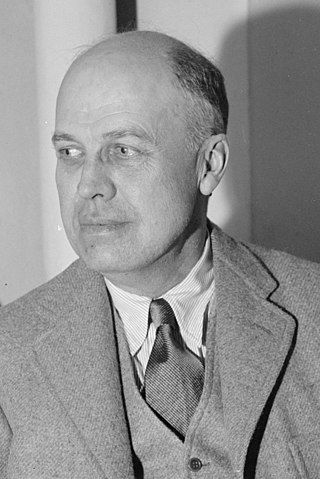
Edward Hopper was an American realist painter and printmaker. While he is widely known for his oil paintings, he was equally proficient as a watercolorist and printmaker in etching.

Richard Diebenkorn was an American painter and printmaker. His early work is associated with abstract expressionism and the Bay Area Figurative Movement of the 1950s and 1960s. In the late 1960s he began his extensive series of geometric, lyrical abstract paintings. Known as the Ocean Park paintings, these paintings were instrumental to his achievement of worldwide acclaim.
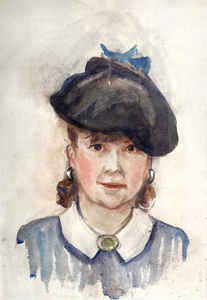
Josephine Verstille Hopper was an American painter who studied under Robert Henri and Kenneth Hayes Miller, and won the Huntington Hartford Foundation fellowship. She was the wife of Edward Hopper, whom she married in 1924.

Nighthawks is a 1942 oil-on-canvas painting by the American artist Edward Hopper that portrays four people in a downtown diner late at night as viewed through the diner's large glass window. The light coming from the diner illuminates a darkened and deserted urban streetscape.

Chop Suey (1929) is an oil painting on canvas by the American artist Edward Hopper. The foreground of the work portrays two women in conversation at a restaurant. In November 2018, it was sold at $92 million, a record price for the artist's work.

Automat is a 1927 oil painting by the American realist painter Edward Hopper. The painting was first displayed on Valentine's Day 1927 at the opening of Hopper's second solo show, at the Rehn Galleries in New York City. By April it had been sold for $1,200. The painting is today owned by the Des Moines Art Center, in Iowa.
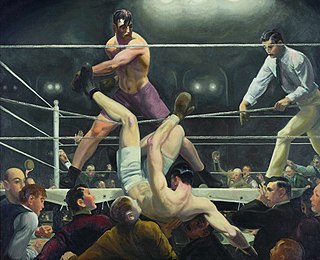
American Realism was a style in art, music and literature that depicted contemporary social realities and the lives and everyday activities of ordinary people. The movement began in literature in the mid-19th century, and became an important tendency in visual art in the early 20th century. Whether a cultural portrayal or a scenic view of downtown New York City, American realist works attempted to define what was real.

Study of a Young Woman is a painting by the Dutch artist Johannes Vermeer, completed between 1665 and 1667, and now in the Metropolitan Museum of Art, New York.
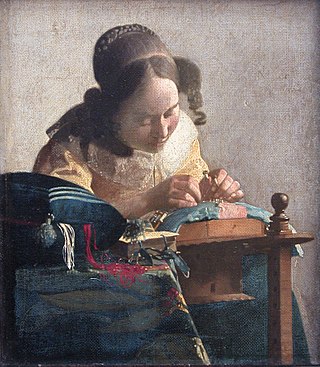
The Lacemaker is a painting by the Dutch artist Johannes Vermeer (1632–1675), completed around 1669–1670 and held in the Louvre, Paris. The work shows a young woman wearing a yellow bodice, holding up a pair of bobbins in her left hand as she carefully places a pin in the pillow on which she is making her bobbin lace.
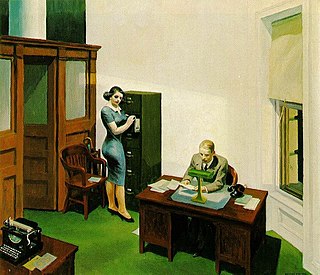
Office at Night is a 1940 oil-on-canvas painting by the American realist painter Edward Hopper. It is owned by the Walker Art Center in Minneapolis, Minnesota, which purchased it in 1948.

Hotel Lobby is a 1943 oil painting on canvas by American realist painter Edward Hopper; it is held in the collection of the Indianapolis Museum of Art (IMA), in Indianapolis, Indiana, United States.

Jennie Augusta Brownscombe was an American painter, designer, etcher, commercial artist, and illustrator. Brownscombe studied art for years in the United States and in Paris. She was a founding member, student and teacher at the Art Students League of New York. She made genre paintings, including revolutionary and colonial American history, most notably The First Thanksgiving held at Pilgrim Hall in Plymouth, Massachusetts. She sold the reproduction rights to more than 100 paintings, and images of her work have appeared on prints, calendars and greeting cards. Her works are in many public collections and museums. In 1899 she was described by New York World as "one of America's best artists."

East Wind Over Weehawken is an 1934 oil painting on canvas by American realist painter Edward Hopper. It was held in the collection of the Pennsylvania Academy of Fine Arts in the United States from 1952 until its sale to an anonymous buyer in December 2013. That sale brought a record price for a Hopper.
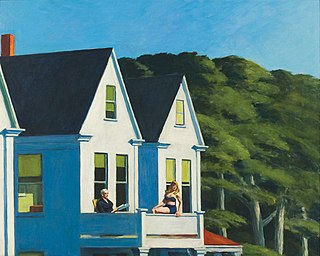
Second Story Sunlight is a 1960 oil painting by the American artist Edward Hopper. It depicts two women of different ages on the second-story balcony of a white house. The older woman reads a newspaper while the younger woman sits on the railing. It is in the collections of the Whitney Museum of American Art, in New York.
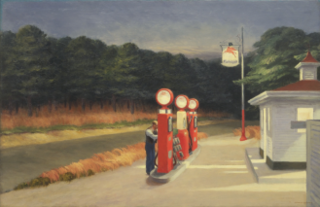
Gas is an oil painting by the American painter Edward Hopper, from 1940. It depicts an American gas station at the end of a highway. The painting belongs to the Museum of Modern Art, in New York.

Young Mother Sewing aka Little Girl Leaning on her Mother's Knee is a 1900 painting by Mary Cassatt. It is in the collection of the Metropolitan Museum of Art.
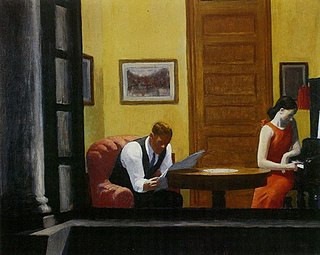
Room in New York is a 1932 oil-on-canvas painting by the American artist Edward Hopper that portrays two individuals in a New York City flat. It is held in the collection of the Sheldon Museum of Art. The painting is said to have been inspired by the glimpses of lighted interiors seen by the artist near the district where he lived in Washington Square.
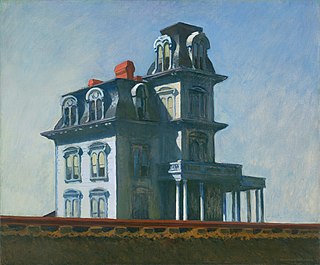
House by the Railroad is a 1925 oil-on-canvas painting by the American artist Edward Hopper.

Sun in an Empty Room is a 1963 painting by American realist Edward Hopper (1882–1967). It is a late period painting completed at his Cape Cod summer home and studio in South Truro, Massachusetts, just four years before his death at age 84. The work depicts a room, seemingly empty, except for light coming through a window, reflecting along the walls and floor. Leaves on a tree or bush can be seen just outside the window.




















